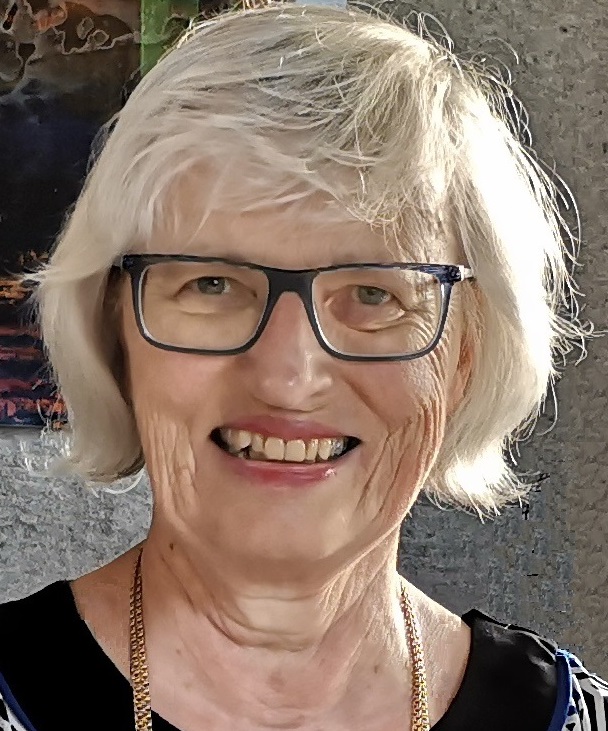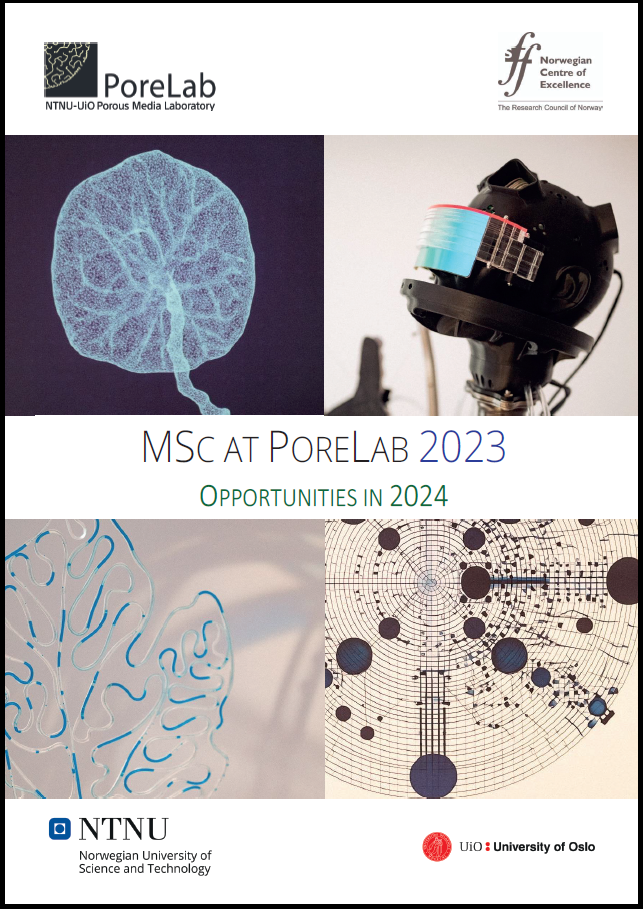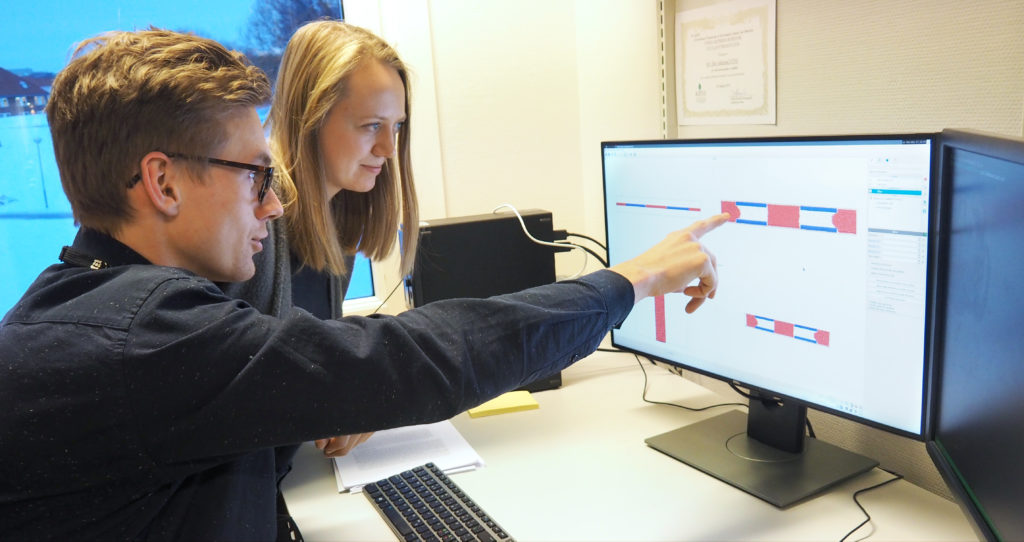Work or Study at PoreLab!
PoreLab would like to have more students! Whether you are a prospect MSc student, PhD candidate or researcher, if your interests and qualifications match our activities, feel free to contact us. Contact juniors to learn about our environment. Contacts the Project Initiators (PIs) and seniors for project possibilities.
PoreLab offers projects for both PhD and Master degrees.
- PhD positions are announced regularly under www.jobbnorge.no and other medias.
- Master students who are interested in developing a project with PoreLab are invited to take contact with the Center members and PIs. Examples of master projects are given at the bottom of this page.
A Message from Signe Kjelstrup, Leader of Graduate School
PoreLab would like to have more Master students!
We therefore invite potential students to make contact with anybody in our crew. Contact juniors to learn about our environment. Contact PIs and seniors for project possibilities!
The projects listed at the bottom of this page are only a fraction of the possibilities. We like to tailor new projects to the particular student’s wishes and can start a new topic this way. The team’s cores are presented in the Annual Report, and on our homepage. They serve also as useful starting points.
The climate crisis is a fact, and PoreLab is putting its weight behind the UN sustainability goals! With all our skills and ingenuity, we want to contribute to production of clean water and a more energy efficient world. Some of the master projects refer to that.
Norway has a high competence on transport of oil through porous media. PoreLab sees it as a mission to bring this basic competence to other fields of application.
We recently obtained a new project to study transport of nanoparticles with in cancerogeneous biological tissue. This is an example of a such a change in direction.
Looking forward to seeing you in PoreLab!

Why Study Porous Media and What Courses to Choose?
Porous media are all around us. In the ground, water fills the pores of aquifers, and oil is found in porous medium. Pollutants may follow rainwater into the ground which is a porous medium; where do the pollutants end up? When underground water rises during earthquakes, they may push the soil particles apart so that it loses it strength with the results that building topple. Less dramatically, but extremely importantly, the physics and chemistry of nanoporous media is at the core of fuel cells, batteries, and in heterogeneous catalysis. They make up concrete and biological tissue. A better understanding of the flow patterns in these materials will make them much more efficient – an important goal in a world that needs to become greener.
In PoreLab we study phenomena of these and related kinds, aiming to understand, improve and use the porous materials in ways that are more environmentally friendly, and more effective than now. An interdisciplinary PoreLab-environment has been constructed to facilitate contact between different disciplines and speed up this development.
PoreLab offers a range of courses open for all students at our host universities.
The two first courses, PoreLab course 1 and PoreLab course 2 are jointly organized between NTNU and UiO. They were adapted to PoreLab with a special focus on porous media physics.
PoreLab Course 1:
FYS4465/FYS9465 (Dynamics of complex media) at UiO or KJ8210 (Flows in porous media) at NTNU
Theory and simulation of flows in complex media
The course covers hydrodynamics where capillary and viscous forces play a role. It also covers simulation methods, thermodynamics and statistical physics relevant to porous media. The course content is motivated in terms of ground water flows, biological tissue, hydrocarbon management, fuel cells, electrophoresis, building materials and the quest for the governing equations.
Background assumed: Equilibrium statistical mechanics. Some students may know about diffusion/Langevin equations/basic theory of Onsager reciprocity relations, others will know the Boltzmann equation. Goal: Bring the student to understand the hydrodynamics of flows in porous media, including thermal gradients and concentration gradients. Also, the student will get a toolbox to simulate the flow in porous media on different scales. The course will support the experimental course in PoreLab.
The course is offered in a digital format in order to welcome students at both UiO and NTNU.
Professor Eirik Flekkøy is the lecturer for this course.
The compendium for the course is available here.
PoreLab Course 2
FYS4420/FYS9420 (Experimental techniques in porous and complex systems) at UiO
Experimental techniques in porous systems
PoreLab course 2 covers experimental techniques related to porous media and is open for students from both NTNU and UiO.
The course is adapted to PoreLab with a special focus on porous media physics. It is organized every year during the fall semester by UiO. The course contains four projects that give students an introduction to important experimental techniques in the field of condensed matter physics. The teaching is based on four projects in which the students apply techniques on realistic problems in condensed matter physics
The course is offered on both Ph.D. and Master level and is open for domestic and visiting students.
Visiting Ph.D. students (NTNU students taking the course at UIO) can find more information on the application process and deadlines on this page.
Application deadlines and procedures for domestic and exchange master and bachelor students can be found here.
Contacts: Professor Knut Jørgen Måløy, UiO
More details on the Ph.D. level course can be found here and the lower level course is described here.
Additional Courses
Within the research fields of PoreLab, NTNU and UiO offer as well the following courses:
- TKJ4200 – Irreversible Thermodynamics, at the department of Chemistry, NTNU
- TFY4230 – Statistical Physics, at the department of Physics, NTNU
- EP8208 – Mass and Heat Transfer in Porous Media, at the department of Energy and Process Engineering, NTNU
- KP8132 – Applied Heterogeneous Catalysis, at the department of Chemical Engineering, NTNU
- TKP4515 – Catalysis, Specialization course, at the department of Chemical Engineering, NTNU
- TKP4107 – Chemical Engineering Thermodynamics, at the department of Chemical Engineering, NTNU
- FY8906/TFY4265 – Biophysical Micromethods, at the department of Physics
- TPG4112 – Geomechanics and Flow in Porous Media, at the Department of Geoscience and Petroleum, NTNU
- TPG 4160 – Reservoir Simulation, at the Department of Geoscience and Petroleum, NTNU
- TPG 4116 – Description and Characterization of Porous Media and Flow by Laboratory Analysis, at the department of Geoscience and Petroleum, NTNU
- PG8607 – Numerical Methods in Reservoir Simulation, at the Department of Geoscience and Petroleum, NTNU
- FYS4460/FYS9460 – Disordered Systems and Percolation, at the Physics department, UiO
- FYS4130 – Statistical Mechanics, at the department of Physics, University of Oslo
MSc at PoreLab 2023 – Opportunities in 2024
Read more about the master projects performed in 2023, life at PoreLab and opportunities in 2024-2025 in our catalogue here:

Examples of Master Degree Projects at PoreLab

Master_Project_2023_2024_Onsager_symmetry_in immiscible_two_phase_flow_in_porous_mdia.pdf


Master_project_2023_2024_shape of Clusters in Immiscible Two-Phase Flow in Porous Media.pdf

Master_project_2023_2024_role_of_system_disorder_and_thermal_noise_in_fracture_growth.pdf

Master_Project_2023_2024_Permafrost.pdf

Master_Project_2023_2024_The_Flow_of_NanoCrystals_2023.pdf

Master_Project_2023_2024_Active_Hydrogels_2023.pdf

Master_Project_2023_2024_Aging in Nematic Gels.pdf

Master_Project_2023_2024_Stabilizing_QuickSand.pdf

Master_Project_2023_2024_Understanding non-newtonian materials.pdf

Master_Project_2023_2024_Modelling extremely low friction of quasicrystals.pdf

Master_Project_2023_2024_Multi-contact superlubricity.pdf

Master_Project_2023_2024_Simulating growth of cancer and the immune system.pdf

Master-Project_2023_2024_Simulating and measuring the contact mechanics.pdf

Master-project_2023_2024_Modelling mechanical properties of 2d materials.pdf

Master_Project_2023_2024_Ultrasound-mediated drug delivery to tumours and brain.pdf

Master_project_2023_2024_Transport of fluids and entropy generation in plant leaves.pdf

Master_Project_2023_ 2024_Counter-current transport of fluids and entropy generation in tree.pdf

Master_project_2023_2024_Remotely-activated nanobombs for selective destroy of cancer.pdf

Master_project_2023_2024_Nature-inspired water and ice-repelling nanostructured surfaces.pdf


Master_Project_2023_2024_Pore-scale investigation of low salinity waterflooding in sandstones.pdf



Master-project-2023_2024_UiO-steady-state-two-phase-flow-in-a-gravitational-field.pdf

Master-project-2023_2024_UiO-CO2-storage-and-stability-of-convection-plumes-in-model-aquifers.pdf

Master-project-2023-2024_UiO-Steady-state-two-phase-flow-experiments-in-3D.pdf

Master-project-2023-2024_UiO-Pollution spreading.pdf


Master-Project-2023-2024_UiO-Pressure-Fluctuation-in-Porous-Media-Flows.pdf

Master-Project-2023-2024_UiO-Influence-of-the-Flow-Speed-on-the-Pore-Invasion-Dynamics.pdf


Master_Project_2023_2024_UiO_Numerical simulation of mixing in microscale multiphase flow.pdf

Master_Project_2023_2024_UiO_Experimental imaging of mixing in porous media.pdf
Master Thesis and Project Assignments 2023-2024 at the Department of Physics, NTNU
Presentations for all Research Divisions at the Department of Physics can be found here.
Presentation for the section “Physics of porous media” can be found here
Join the Thermodynamic Group at the Department of Chemistry, NTNU!
Are you interested about understanding the mechanisms behind conversion of energy? Thermodynamics is the science of energy conversion, especially the relationship between heat and work. This field of study formulated the working principles of many renewable energy technologies, on the macro- as well as nano-level, where work is created from chemical energy and heat. The Thermodynamic group believes that better comprehension helps utilize existing and new sources of energy in an efficient manner.
Are you interested in learning more about the Thermodynamic group, visit the website here:
Interested in doing your master at the Thermodynamic group? Read more information here.
Presentation of the Thermodynamic group (in Norwegian) >>


